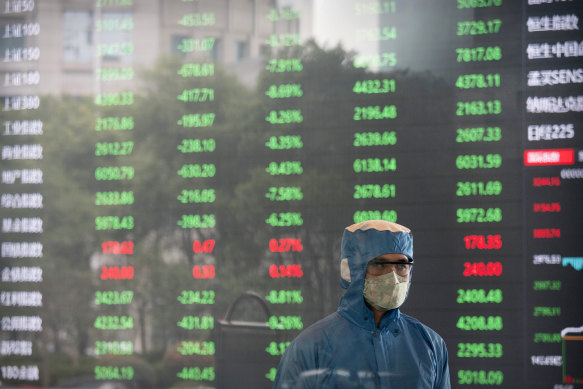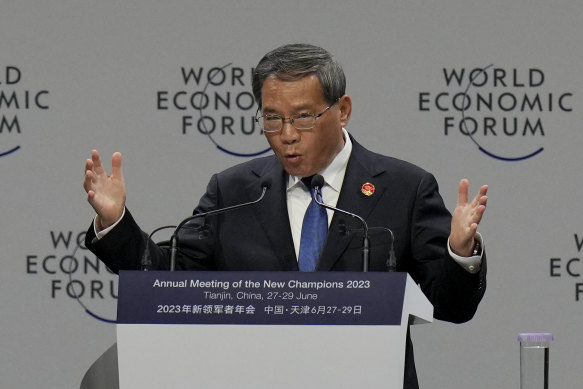This was published 1 year ago
Opinion
Horror show: China rattled by $9 trillion meltdown
Stephen Bartholomeusz
Senior business columnistChina’s leadership appears to be rattled by the accelerating three-year sharemarket rout that has enveloped their markets. The dramatic sell-off, however, is a symptom of a more fundamental malaise and therefore the rescue package now being mooted would be more a Band-Aid than a cure.
With more than $9 trillion wiped off the mainland and Hong Kong markets since they peaked in February 2021, there has been an increasing sense of urgency in Beijing as the pace of the dumping of Chinese stocks picked up again this month.

China’s benchmark index has fallen by more than 40 per cent over the past three years. Credit: AP
The Shanghai Shenzhen CSI 300 index has fallen nearly 6 per cent this month, taking its three-year collapse to more than 40 per cent. The Hong Kong market’s Hang Seng China Enterprises Index has tumbled almost 11 per cent so far this year, taking its three-year decline to closer to 60 per cent.
The authorities have implemented modest measures to try to stabilise the markets, limiting short selling, cutting stamp duties on trades, ordering some big institutional investors not to sell their shares and directing state-owned financial institutions to buy exchange-traded funds.
Now, according to Bloomberg, they are considering deploying about 2 trillion yuan ($425 million) of funds held in the offshore accounts of state-owned enterprises to invest in Chinese companies listed in Hong Kong, with a further 300 billion yuan of mainland funds used to support mainland markets.
Earlier this week China’s powerful State Council (the equivalent of Australia’s federal cabinet) was briefed on the state of the markets and, according to China’s state-owned media, discussed the need to improve the basic market systems, focus on a better balance between investment and financing, improve the quality and investment appeal of listed companies, increase the entry of medium and long-term funds to the market, and improve its stability.
Premier Li Qiang is said to have ordered authorities to find ways to attract long-term investors.
The sense that the authorities are taking the market rout seriously and reports that a rescue package is on its way underpinned a modest positive blip in the markets on Tuesday, but it is unlikely that anything that those in Beijing have said or done thus far will end the negativity about the outlook for the markets.
The rescue package, if it is as envisaged, might provide some temporary relief – and a window for investors to sell into a market with some buying support – but trying to address the symptoms of a problem rather than the problem itself is unlikely to provide a lasting change in investor sentiment.
It is understandable that the authorities would be unsettled by the markets’ implosions.
China already has a property crisis, with sales and prices still falling and more than 50 developers, including many of the largest, defaulting on their debts.
With property the major asset class held by China’s middle class, the wealth and confidence effects of the meltdown in the market are weighing heavily on the economy.
When the impact of the sharemarket falls and stresses within the $4.5 trillion shadow banking sector (which invest household funds in, among other things, property and shares) are added to that wealth destruction in an economy with a limited social security net, it’s not surprising that China’s consumers are experiencing financial pressures and insecurity.
An exodus of foreign investors and financiers (foreign bond investors have borne the brunt of the property debt-related losses) has added to the downward pressures on both markets.
Beijing has deployed similar measures to those being mooted in efforts to halt major market sell-offs in the past, most notably in 2015, when a stock market bubble popped and – in response to the subsequent savage falls in the market, which saw about a third of the value of the Shanghai market wiped out in a few weeks – there were bans on short-selling, the government provided cash to brokers via the People’s Bank of China to acquire shares, there was a six-month ban on substantial shareholders selling their shares, and nearly half the listed companies suspended trading in their shares. People were arrested for “spreading rumours” or for market manipulation.
The market eventually stabilised at a level about a third lower than before the crash, but it is doubtful that the kitchen sink the authorities threw at the market had anything but marginal and temporary impacts.
The reason the markets have slumped over the past three years is obvious, and it has little to do with the markets’ functioning.
It is unlikely that anything that those in Beijing have said or done thus far will end the negativity about the outlook for the markets.
Trying to deal with the markets in isolation from the influences that have driven the protracted sell-off would be a waste of funds and attention if it were designed to do anything but avert an even more panicky sell-off that could morph into an actual financial crisis.
China’s economy, after decades of the superior growth rates that drove the appeal and expansion of its financial markets, is being challenged by its structural flaws.
Its growth rate has slowed to (excluding the pandemic) its lowest rate in 30 years. The property sector that once, with its related activity, generated about 30 per cent of China’s GDP continues its dramatic shrinking.
Export-oriented factories are, thanks to over-investment, a global economic slowdown and the trade tensions between China and the West, awash with over capacity.

Chinese Premier Li Qiang is said to have ordered authorities to find ways to attract long-term investors.Credit: AP
Infrastructure investment, historically twinned with property market stimulus as the antidote to economic threats, is increasingly unproductive.
Xi Jinping’s crackdowns on property and technology companies and the use of revised espionage laws to cut off the flow of economic and corporate information to foreign companies has had a chilling effect on foreign direct investment and private sector activity, making the economy more reliant on state-owned enterprises that are less efficient.
China’s debt-to-GDP ratio is at record levels – 286 per cent of its GDP – and its local governments, key conduits for implementing Beijing’s financial policies, are highly leveraged and have lost much of the property-related income they have relied on.
The population is rapidly ageing and now shrinking, and consumers aren’t taking up the slack caused by the property sector’s woes.
With weaker global demand, the shift to “reshoring” and “friendshoring” of industrial activity in the wake of the pandemic, and the impact of America’s tariffs and bans on sales of advanced technology to China, China’s manufacturing sector and its exports are also weakening.
Most of these issues are structural and long-term, but Beijing has yet to devise a new set of policies that address the challenges.
Providing subsidies for even more manufacturing, even if it is in 21st century sectors, is not – as the excess manufacturing capacity and vast and growing inventory of unsold electric vehicles in China illustrates – a surefire recipe for success.
The sharemarket rout is a reflection of the brittle state of China’s economy and the question marks that have been raised over its outlook, not (unless it does develop into a full-scale panic) a cause of the issues Beijing is confronted with.
The Business Briefing newsletter delivers major stories, exclusive coverage and expert opinion. Sign up to get it every weekday morning.